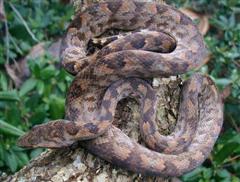Boa - Sololon Island Tree
Papuan Tree Boa Scientific Name: Candoia bibroni australis
Mon, 28th April, 2025 - 8:12 am GMT
Sponsor Ads:

Alternative Name
Papuan Tree Boa Scientific Name: Candoia bibroni australisBasic Info
Male Solomon Island Tree Boas grow to be about two to three feet while females are usually four to five feet in length. They have triangular, flat heads and often are described as having a venomous or prehistoric appearance. The scales are keeled and Solomon Island Tree Boas vary in color from pink, gold, chocolate brown, or black. Some have gray-green, pink, or even red blotches.
Health
Solomon Island Tree Boas are easy to breed. Keep the Boas at 80 degrees in the day but drop the nighttime temperature to 70 degrees for six to eight weeks when you wish your Solomon Island Tree Boas to breed. Drop the temperature from November to December and then in January introduce your breeding pairs to each other. If the snakes breed from December to April, neonates will be born from September to January. Usually two females to several males work best, but multiple males are always required. Placing up to ten Solomon Island Tree Boas in one cage seems to work very well; as the snakes pair off, move them into a private enclosure so they may copulate. Some Solomon Island Tree Boa males will mate with all the females; others will choose only one with which to copulate. Solomon Island Tree Boas will usually bear from 5 to 15 neonates. The neonates are often difficult feeders but do need to eat every seven to ten days. If they will not accept pinkie mice try scenting this food with tree frogs. If the neonate Solomon Island Tree Boas persist in stubbornness, allow them to eat tree frogs for five or six meals and then do not feed them for about three weeks. Reintroduce the scented pinkies; at this point the neonate will be extremely hungry and more likely to accept it.Habitat
Found in the Pacific Solomon Island archipelago, where they live in trees and will occasionally come to the groundBehavior
One of the smaller boas, the Solomon Island Tree Boas are extremely beautiful and captive bred specimens are very docile. These little known boas are the favorite snakes of many that are fortunate enough to own them. Solomon Island Tree Boas are small so they do not require a lot of space; a pair will do nicely in a 35-gallon tank. Because they are used to tropical climes in the wild, it is important to devote lots of time to regulating the temperature and humidity levels in the enclosures of your boas. The humidity level should be around 60%, and the cage should have a hot spot of 85 to 95 degrees Fahrenheit with a cooler side of 75 to 85 degrees. Usually Solomon Island Tree Boas prefer cooler temperatures, even gravid females. Be sure to provide many tree branches for these arboreal boas and a hide box where they may retreat when they become stressed. Butcher paper, newspaper, or aspen shavings make good substrates, but as usual, never give cedar.It is very important to make sure your Solomon Island Tree Boas have a bowl for soaking and for drinking. These Boas love to soak! They may also appreciate your misting their cage once a week. Solomon Island Tree Boas have striking coloration and are gaining in popularity as pets. Captive bred Solomon Island Tree Boas have the advantage of carrying fewer parasites and infections than wild-caught boas. Captive bred Solomon Island Tree Boas have sweet, friendly personalities and are calm, docile pets.Origin
Solomon IslandsHistory
Solomon Island Tree Boas, true to their name, are found in the Pacific Solomon Island archipelago, where they live in trees and will occasionally come to the ground. Generally, they live in forests near rivers, but will stray close to human dwellings as long as they can find many rodents on which to subsist.Common Foods
N/ASponsor Ads:
The only government handout that I want is the government's hand out of my pocket. -- Unknown
Boa - Sololon Island Tree
Coded by: BGID® | ALL RIGHTS RESERVED Copyright © 2000-2025
Disclaimer | Privacy | Report Errors / Contact | Credits








 President of the United States of America - Real Estate mogul, Pageant owner and now one of the most controversial men in political history.
President of the United States of America - Real Estate mogul, Pageant owner and now one of the most controversial men in political history.  Politician, US Vice President and President of the USA - Joseph Robinette Biden Jr.
Politician, US Vice President and President of the USA - Joseph Robinette Biden Jr.  versus
versus  Russia: 'The Evil Empire'? Are they all that bad or is it just the USA trying to portray Russia as bad because they are a world power with land bigger and a society very different from the USA ideal?
Russia: 'The Evil Empire'? Are they all that bad or is it just the USA trying to portray Russia as bad because they are a world power with land bigger and a society very different from the USA ideal?  Global warming has been in and out as the "latest" hot topic for many years. It is, according to modern scientists, the result of man-made industrial pollutants, clearing forested areas, agriculture, etc. But now they are thinking it started way before the Industrial Revolution...
Global warming has been in and out as the "latest" hot topic for many years. It is, according to modern scientists, the result of man-made industrial pollutants, clearing forested areas, agriculture, etc. But now they are thinking it started way before the Industrial Revolution... 
 Corona virus
Corona virus 
 Users with wide screen monitors can benefit from more content on every page.
Users with wide screen monitors can benefit from more content on every page.